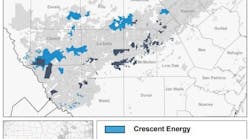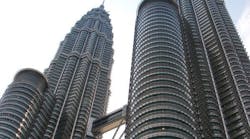Robert Wasserstrom, Susan ReiderIn January 1986, Conoco Inc. signed an agreement with the Ecuadorian government to explore for hydrocarbons on Block 16, a 500,000-acre tract of nearly virgin forest in the Amazon basin.
Terra Group Inc.
Houston
Within 3 years, the company had found 200 million bbl of oil. To develop this discovery, Conoco and its partners proposed to build two secondary pipelines connecting their field to the Trans-Ecuadorian Pipeline System (SOTE), Ecuador's main oil export line, as well as a 120-km road alongside the feeder lines.
Opposition to this plan arose almost immediately. Block 16 includes the Yasuni National Park, an area of world-famous biological diversity that had been largely protected from outside settlement or disturbance.
It also includes traditional territories used by Huaorani Indians, a federation of isolated and nomadic bands whose legal reserve lay only 50 km south of block's borders. (In 1990, the Ecuadorian government expanded this reserve into Block 16 by transferring 1.2 million acres from the Yasuni Park.)
Environmental opposition
Beginning in 1986, two environmental organizations-Rainforest Action Network (RAN) in San Francisco and Fundacion Natura in Quito-warned Conoco against exploring for oil in this highly sensitive area.That same year, RAN also began to build a coalition of small "radical" groups in the U.S. and Ecuador that rejected all petroleum development in the rain forest. In 1988, it issued two "action alerts" that laid the groundwork for a long-term strategic alliance between previously separate activist communities: traditional conservationists (who wanted to preserve Yasuni) and human rights advocates (who were concerned about the Huaorani).
Eventually, RAN's opposition focused on Conoco's plan to build an access road into pristine areas. RAN and its allies argued that the road would allow uncontrolled settlement of the forest by landless peasants from other regions (this had already occurred in production areas operated by Petro- ecuador immediately north of Block 16).
According to RAN, such settlement would bring prostitution, alcoholism, and death to Huaorani villages.
Conoco response
At first, Conoco's response was primarily technical.The company designed a detailed environmental management plan (EMP) for operating in Yasuni park that included extensive safeguards against illegal settlement and other problems. But it waited nearly 3 years to meet with environmental and human rights organizations or to ask for their opinions. A "special team" to work with stakeholders was not formed until September 1989, as the project moved from exploration to development.
Once the company was ready to talk, it met with major environmental groups to test the idea of creating an independent foundation that would oversee conservation efforts in Block 16. It took their comments seriously and later revised its EMP to address their concerns. In May, 1990, it convened a meeting on the Napo River with representatives of more than 30 NGOs and research institutions to review the modified plan.
But by then, events were spinning out of control. A few weeks after the Napo meeting, the Sierra Club Legal Defense Fund filed a petition with the Inter-American Commission on Human Rights (a branch of the Organization of American States), alleging that Conoco's proposed development meant "ethnocide" for the Huaorani.
Simultaneously, indigenous organizations and environmental activists occupied the company's offices in Quito, while RAN announced a campaign of demonstrations against Conoco in the U.S. A small public-interest law firm in Quito asked the U.S. Department of Justice to investigate company operations under the Foreign Corrupt Practices Act. Finally, in September 1991, despite public support from two major American NGOs (the Natural Resources Defense Council and Cultural Survival), Conoco evaluated this project against other opportunities worldwide and decided to leave Ecuador.
In retrospect, Conoco managers who participated in these events now say that they should have engaged NGOs and other stakeholders from the beginning. Unfortunately, deep fault lines within the company-principally between explorationists and other groups-made such action difficult and helped put Conoco on the defensive, even when opponents' strategies were clear and could be anticipated. In effect, Conoco gave its opponents 3 years to organize, recruit allies, refine messages, and raise money.
The company also lost early opportunities to work with moderate environmental groups and human rights organizations. Whereas virtually all of these groups objected in principle to oil production in national parks, they also split between those that understood that petroleum development was inevitable and were willing to "cut the best deal for the environment," and those, like RAN, that rejected any intrusion into such areas.
By moving too slowly to engage moderate NGOs, Conoco in effect allowed public debate to be dominated by the radicals. And once those radicals had defined the terms of debate-Do you support the Huaorani or do you support Big Oil?-even environmental leaders who agreed with Conoco found themselves facing tough questions from board members or constituents.
The Authors
Robert Wasserstrom, president of the Terra Group in Houston, has spent more than 25 years working with native communities, environmental groups, and other stakeholders in Latin America and the U.S. He served as vice-president of public affairs at Browning-Ferris Industries in Houston before founding the Terra Group with Susan Reider in 1993 to help energy companies manage their stakeholder relations. He holds a master's degree and Ph.D. in anthropology from Harvard University.
Susan Reider, vice-president of The Terra Group, has more than 20 years of legislative and political experience. She has worked extensively with non-profit organizations and assisted energy companies to win local support for major capital projects. At present, she is advising several oil companies in Latin America. She holds B.A. degrees in public communications and political science from Syracuse University.
Copyright 1997 Oil & Gas Journal. All Rights Reserved.




